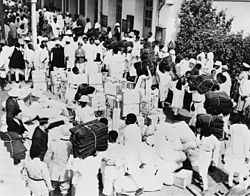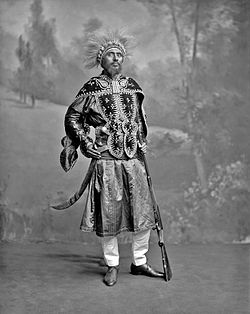Cotton is grown throughout Ethiopia at elevations above 1000 meters and below 1400 meters.[1] Because most of the lowlands lack adequate rainfall, cotton cultivation depends largely on irrigation.


History edit
Cotton production has long been underway in Ethiopia. Before the revolution, large-scale commercial cotton plantations were developed in the Awash Valley[citation needed] and the Humera areas. The Tendaho Cotton Plantation in the lower Awash Valley was one of Ethiopia's largest cotton plantations. Rain-fed cotton also grew in Humera, Bilate, and Arba Minch.
In 1867 it was reported that there were plans to construct a 362-kilometre (225-mile) road from the Ethiopian cotton fields to the Red Sea to trade with Egypt and Turkey.[2] Since the revolution, most commercial cotton has been grown on irrigated state farms, mostly in the Awash Valley area. Production jumped from 43,500 tons in 1974/75 to 74,900 tons in 1984/85. Similarly, the area of cultivation increased from 22,600 hectares in 1974/75 to 33,900 hectares in 1984/85.[1]
Given its excellent growing conditions, abundance of raw materials and availability of land, Ethiopia has the potential to become a major global cotton producer but the cotton industry in Ethiopia as of 2011 is far behind that of the coffee industry and cereal production.[3] There are however, significant obstacles to the development of the industry in Ethiopia due to a distinct lack of administrative bodies to monitor and certify agricultural practices in the country and to process cotton in factories on a wide-scale commercial level. However, the development of the textile industry is a priority of the Ethiopian government in their economic growth strategy and in 2006 implemented an important privatization initiative to attract foreign and private enterprises to develop the sector.[3] Despite its lack of governance, the Ethiopian cotton industry is self-sufficient and as of 2002 provides some 50,000 tons annually to the textile industry of Ethiopia.[4]
References edit
- ^ a b Wubne, Mulatu. "Agriculture" (and subsections), A Country Study: Ethiopia (Thomas P. Ofcansky and LaVerle Berry, eds.) Library of Congress Federal Research Division (1991). This article incorporates text from this source, which is in the public domain.[1].
- ^ Beke, Charles Tilstone (1867). The British captives in Abyssinia. Longmans, Green, Reader, and Dyer. p. 301. Retrieved 2 November 2011.
- ^ a b U.S. International Trade Commission. Sub-Saharan African Textile and Apparel Inputs: Potential for Competitive Production, Inv. 332-502. DIANE Publishing. p. 4. ISBN 978-1-4578-1686-4. Retrieved 2 November 2011.
- ^ Gillespie, Carol Ann (1 November 2002). Ethiopia. Infobase Publishing. p. 103. ISBN 978-0-7910-7106-9. Retrieved 2 November 2011.
Further reading edit
- Kassa, Belay (1966). Cotton production in Ethiopia: development of the cotton industry, current status, problems, research needs and proposals. Cornell Univ.